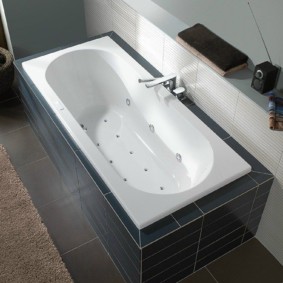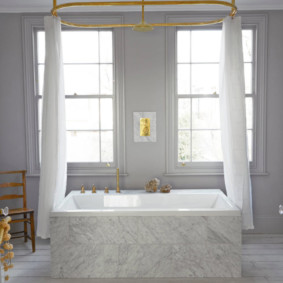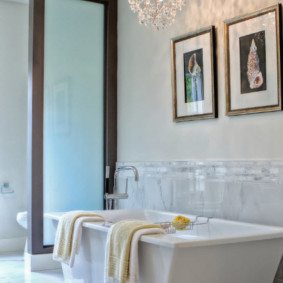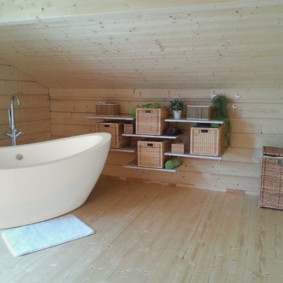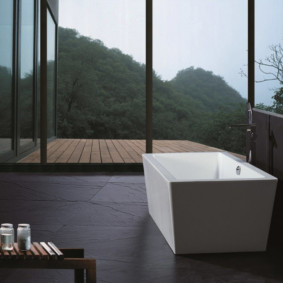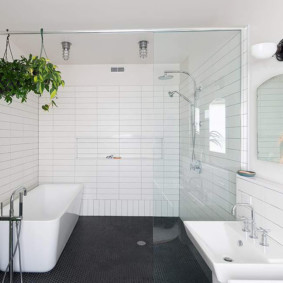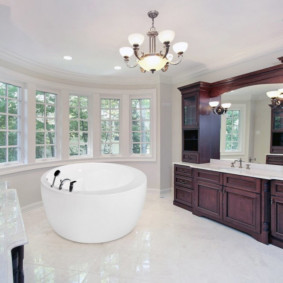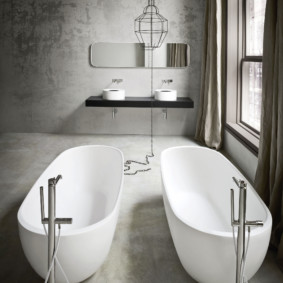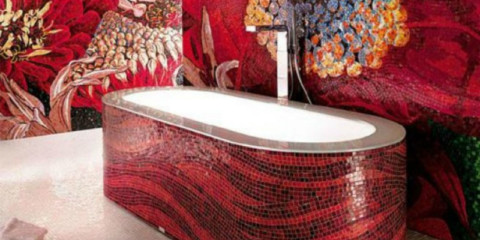 A bathroom
How to choose the layout and interior design of a bathroom of 6 square meters. m
A bathroom
How to choose the layout and interior design of a bathroom of 6 square meters. m
Acrylic bathtubs confidently gaining ground, displacing metal models from the market. How are they better than traditional ones, and are they so good, as the advertisement says.

The popularity of acrylic bathtubs is due to both technical characteristics and attractive appearance of products
What is an acrylic product?
Content
- What is an acrylic product?
- Pros and cons of acrylic bathtubs
- How to choose a bath: useful tips
- Dimensions and shape of acrylic bathtubs: varieties and selection tips
- Different types of acrylic for making
- Proper Acrylic Bath Care
- Varieties of acrylic bathtubs
- The best acrylic bathtub with shower
- What else you need to know about acrylic bathtubs
- Video: Secrets to choosing a quality acrylic bathtub
- Acrylic bathtub in the interior - 50 photos
The chemical industry is creating ever new materials; acrylic plastic has become a discovery for plumbing, furniture manufacturers and designers. Its transparent options are called glass. For baths use plastic. Acrylic coating makes the surface of the metal bath more pleasant to the touch, the most unusual color solutions are available.

Excellent plasticity of acrylic allows you to create products of a wide variety of forms.
Physical characteristics of acrylic:
- It has good light transmittance, it is not important for a bath, but in other interior solutions this property is on hand, for example, interesting partitions are made from it.
- Acrylic is lightweight, due to this quality an acrylic bathtub is much lighter than classic cast-iron.
- High impact resistance, elasticity and ductility.
- Simplicity of processing: it is easy to engrave on acrylic and form a figured product of any shape.
- The material is eco-friendly and hygienic.
- Resistant to chemical influences, that is, it can be cleaned with household chemicals without fear of damage.
Pros and cons of acrylic bathtubs
There is no absolutely ideal in the world, and in a created by nature, and in a man-made, against the background of virtues, there will certainly be a small but disadvantage. Acrylic bathtubs have their pros and cons.

Acrylic is a light material, so even large bathtubs weigh little in comparison with cast iron and steel models
Positive traits:
- lightness - it is easy to deliver it from the store, bring it to the floor and install it easier than the metal analogue;
- fungus or mold will not settle on the acrylic surface, it is safe in this sense;
- rust does not appear on plastic over time;
- high wear resistance allows you to maintain perfect surface smoothness for many years;
- from plastic make baths of the most bizarre and original forms.

Acrylic rejects any bacteria, is easily cleaned and tolerates the effects of acids used in everyday life.
Negative properties:
- strong blows to the product do not exclude chips and cracks;
- not suitable for overweight people, a large load can lead to deformation of the bath.

The properties of acrylic material allow you to produce models of various colors and shades
How to choose a bath: useful tips
Having decided to change the old bath, which has become bored or worn out, to a new, practical one, and in order to be inexpensive, you should not buy the first one you have. To choose a bath from acrylic should be guided by the advice of experts.
- The thickness of the acrylic sheet. Acrylic is the basis of the product, therefore, the thicker it is, the better. Budget options are made with a thickness of 4-5 mm. If you want a solid bath, then the thickness should be from 6 mm and above.

The thickness of the acrylic sheet directly affects the life of the bath
- Reinforcement layers. In the role of a reinforcing composition, special resins are used.The more armolayers, the more reliable your acquisition. At the cut of the bath rim, these layers can be noticed with the naked eye.

The reinforcing layer is applied to the outer surface of the acrylic bath
If the edge is not visible, then you can determine the presence of reinforcing resins by knocking. A bathtub with many layers responds with a dull sound.
- The high quality of the product is indicated by a perfectly flat surface and uniform coloring of the plastic.
- The bathtub should have a strong frame - this is a metal structure where the bowl is installed, relying on the corners, in addition to the frame there must be stiffeners and several reliable supports.
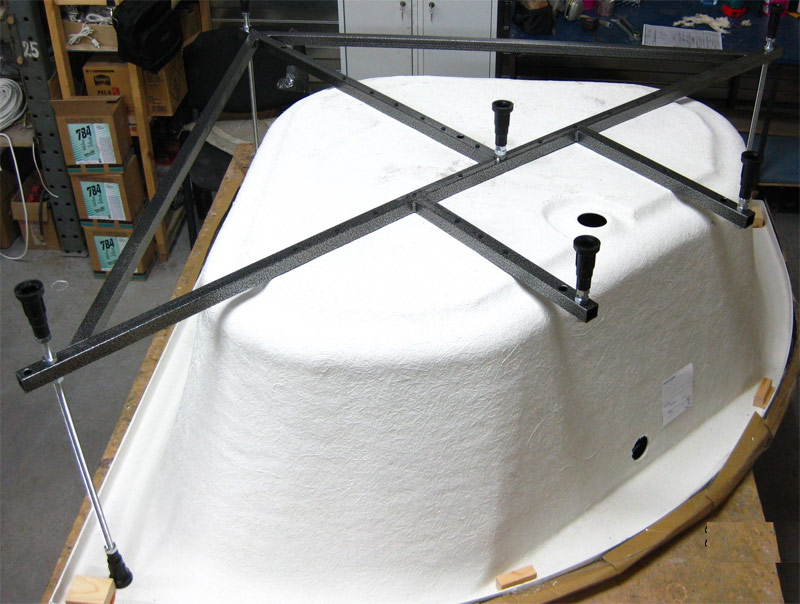
The simplest frame is a welded or prefabricated frame made of a metal profile
- Drain system. The highest quality siphons made of chrome-plated brass are considered. The drain hole can be closed in the usual way or have a semi-automatic closing system.

A high-quality drainage system ensures uninterrupted operation of the acrylic bathtub
Corner baths take up little space, will be a salvation for owners of small apartments.

Comfortable corner bathtub in popular size 150x150 cm
Dimensions and shape of acrylic bathtubs: varieties and selection tips
When choosing, you should not forget about the size, so before buying it is advisable to assess the capabilities of the bathroom, the growth and complexion of your family members. In stores you can find any sizes from small to giants. If the bathroom is modest in size, a bowl of 120 * 70 cm is suitable, for the royal apartments there is a font 190 * 120 cm.

Comfortable placement in the bath depends on the length of the bowl and the height of the person
- The optimal height of the product is 65 cm, both an adult and a child can easily get into such a bath.
- The internal depth is 40-60 cm. The shallow one will be chilly and uncomfortable, while the deep one will be uncomfortable, after all, a bath is not a pool.
- The length varies from 150 to 180 cm, here the choice depends on the maximum growth of the owners.
- The width should also be selected individually, there are plenty to choose from: from a minimum of 65 cm to 120 cm.
The shapes of the bathtubs can be the most bizarre, here the choice depends on the originality of the owners and the area of the bathroom. Want to splash around in a round or hexagonal bath? Please, the main thing is that she does not block the room, creating inconvenience.

White rectangular bathtub with rounded corners in a Scandinavian interior

Compact acrylic bowl with red outer wall for a Japanese-style bathroom

Wave-shaped bathtub for a modern interior
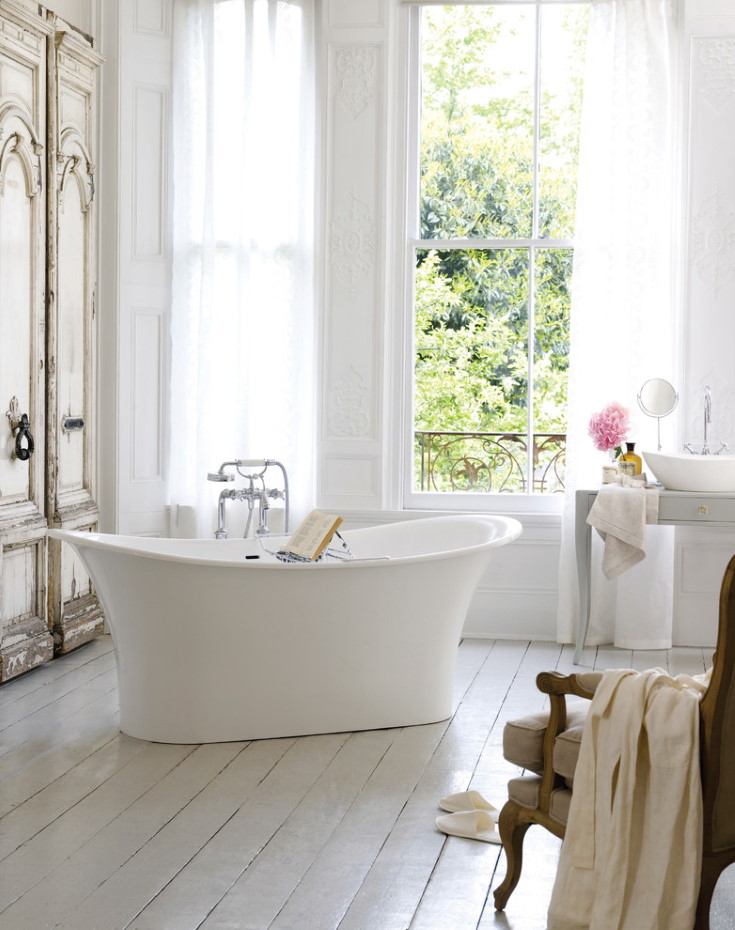
Provencal style bathtub with a graceful bowl
Different types of acrylic for making
There are 2 methods for manufacturing bathtubs: casting and extrusion.
- A bath obtained by casting is more expensive than extruded. For its manufacture, high-quality 100% acrylic is used, it is pressed and reinforced with polyester resins. The surface is perfectly smooth, without pores and roughness, does not change color and is easy to clean.
- Extrusion implies that in addition to acrylic and a reinforcing layer, ABS plastic is also included. This reduces the cost of production, but at the same time affects its quality. The surface may turn yellow over time, less resistant to scratches and chemical influences.

The strength of an acrylic bowl largely depends on the method of its manufacture.
Proper Acrylic Bath Care
In order for the acrylic bath surface to remain glossy and beautiful for as long as possible, you should properly care for it.
- Taboo is applied to any abrasive products: soda, powders, cleaning products, rough sponges. All of them will easily scratch the surface, dirt will accumulate in micro-scratches and the product will lose its presentable appearance.
- The acrylic surface is washed with liquid soap using a soft cloth. In areas with hard water, after washing, wipe the bath dry so that limescale does not deposit.
- On sale you can find special means for washing such bathtubs, it is applied to the surface and washed off after a few minutes. It itself dissolves plaque and soap scatters, leaving the bowl clean.

Compliance with the basic rules for care will ensure a perfect appearance and long service life of the acrylic bath
No worse than a special tool, an acrylic bath is washed with warm water, acidified with vinegar or citric acid.
Varieties of acrylic bathtubs
Plastic acrylic allows you to create products of various shapes. Thanks to this quality, steps, comfortable armrests and ledges for bath accessories are possible in bathtubs.

Compact right-hand corner bathtub 150x70 cm

Stylish acrylic bathtub with a rectangular bowl
Baths are:
- angular;
- round;
- rectangular;
- oval;
- polygonal;
- asymmetric.

Small seat model with glass insert
The more complex the shape, the more likely it is that thin plastic is used.
A rectangular bathtub in a traditional style is in demand and allows you to carry out water procedures with comfort. Corner models combine well with a flexible shower.

A strict bathtub with clear lines - perfect for minimalism
The best acrylic bathtub with shower
Fans of baths and souls were divided into 2 camps. If your family has a similar situation, it is best to choose a 2-in-1 shower bath model.
This will allow:
- soak up and “soak” those who like to swim for a long time;
- quickly freshen up in the morning and not waste time typing in a bath;
- bathe the baby, wash, wash the little dog;
- make rain for indoor flowers under the shower.
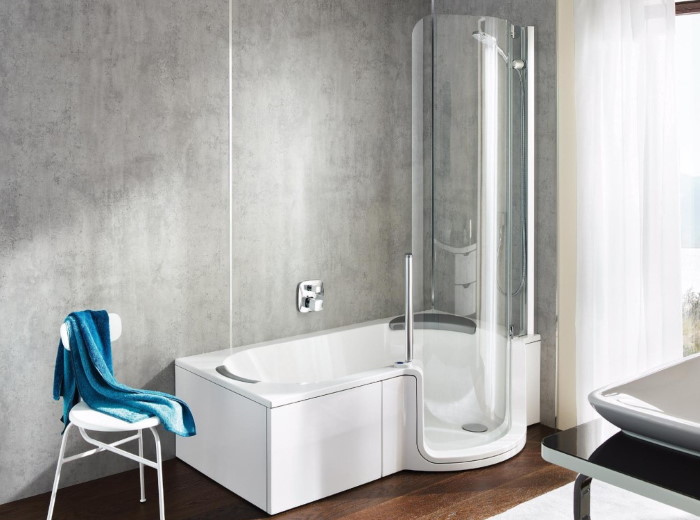
Bathtub with an open shower - a place for showering is covered by a small glass partition
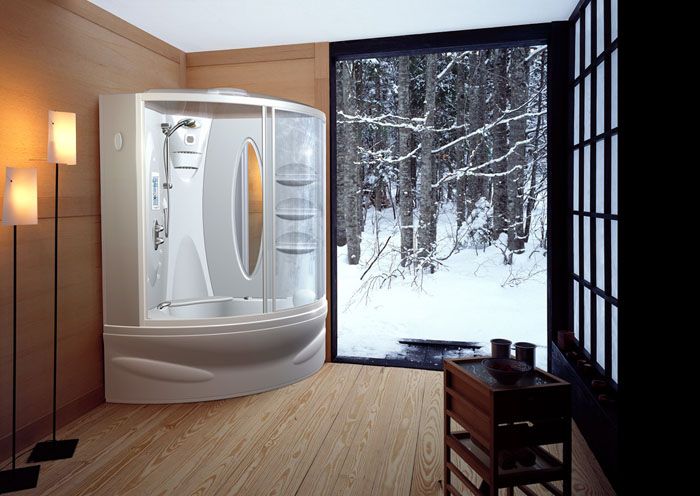
Bathtub with closed shower - the bowl is completely closed by sliding partitions and a sealed roof
Comparison of shower and bath does not give a clear advantage to either one or the other. Professionals advise to weigh the pros and cons, to be guided in the choice not by the argument “I liked it”, but by practical use.
What else you need to know about acrylic bathtubs
Acrylic, like any polymer, does not like high temperatures. It is not advisable to smoke in the bathroom or leave a heated curling iron on its side. If you have pets (cats, dogs), to prevent scratches from claws on the surface of the bathroom, you should buy a special rubber litter on the bottom.

When choosing acrylic plumbing, carefully consider the surface for roughness and gaps, the presence of any errors - an excuse to refuse to buy this particular model
It is forbidden to pour aggressive chemicals (chlorine, paints, etc.) into the bathtub, if you are used to rinsing everything in the bathroom during the repair, you will have to wean it so that the accessory does not lose its gloss and does not become stained.
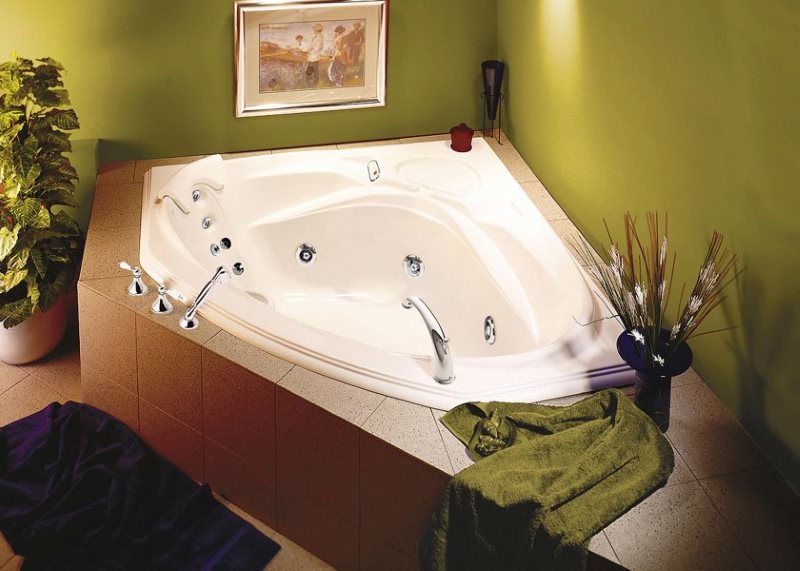
The cheapest options are offered by Russian, Turkish and Chinese manufacturers of bathtubs. Advanced models are equipped with hydromassage and other useful features.
You can restore the bath yourself, covering the scratches with a liquid acrylic composition.
Video: Secrets to choosing a quality acrylic bathtub




